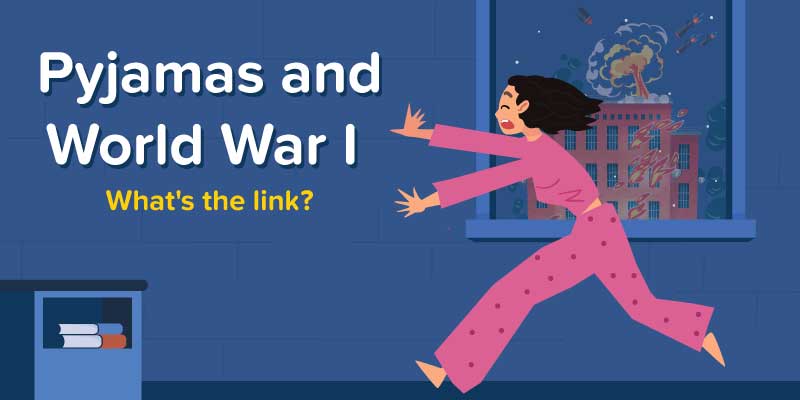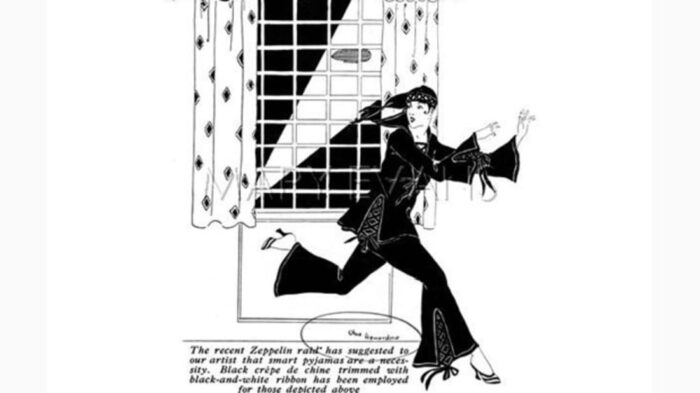A Shocking Connection Between Pyjamas and World War I

World War I introduced the world to so many terrifying new ways war can bring havoc and destruction, and chief among those was, of course, the new terror of airplane bombings.
It was the first time that Britain came under attack from the air. You didn’t even have to be a soldier. For Londoners, the threat began in January 1915, when the Germans sent zeppelins loaded with bombs. Eventually, they sent planes, too.
The air raids, often at night, accomplished little, but their true purpose was to terrorize civilians, cause destruction and sink British morale.
Small details give a human touch to our understanding of what happened during those night air bombings.
For example, the typist whose life was saved because she dashed back to her desk for her handbag during a raid, and so missed the worst of the bomb blast. A child, identified only by the unusual shirt button stitched on his cuff just the night before the bombing.

Aldwych tube station being used as a bomb shelter in 1940
The air raids brought the war to the home front. The war entered the bedroom, the most private space of all. And thus, it had quite an effect on fashion.
Think about it this way: Bedclothes are among the most casual clothes. But with the advent of nighttime raids, people would suddenly be asked to evacuate their homes and would be on the streets at a moment’s notice. Forget Instagram, this was the original “I woke up like this”!
A crumpled nightdress would no longer do. It was a matter of practicality! But also a matter of looking good!
The Rise of Pyjamas: A Statement of Courage

As the bombings continued, distinct trends took hold. Pajamas, or “pyjamas,” as the English called them—became especially popular. Women in trousered attire of any kind was a new phenomenon in 1915 and many magazines saw pyjamas simply as ‘the season’s novelty ‘.
But they ended up being much more than a season’s novelty—“pyjama” sets are hanging on the racks of your local shops even today!
But not just that, pyjamas were considered fashionable and women would wear them every night. During the air raid they would run out of their homes – dressed in these silky, beautiful yet practical pyjamas, ready for action while looking entirely presentable!

An air raid sleeping suit from 1918/ Lucy Adlington
Pyjamas were both warmer and more practical than thin nightdresses during air raids, attractiveness was important too.
Now, you must be thinking how unnecessary it is to think about how you look when there are bombs falling from the sky, right?
Well, remember how the only reason Germans were bombing the common people in the cities of England was because they wanted to break their morale and spirit? Fashion was the way women were defying war and keeping the morale up.
The message was this: “so you want us to get scared by these bombs? We are not scared! We’d rather think about what to wear when we go out in the night”. That’s some great way of showing courage, isn’t it?

A diary entry from 1916 shows life went on despite the raids: “Quiet day. Zepp raid. I saw it. Had my hair shampooed”.
Among the more courageous ones was a fashion editor, quoted by the historian Lucy Adlington: “I do want a little zep scare, so that I can wear them,” the editor confessed about her black silk pyjamas. “Of course I don’t want anyone to be killed.”
The Brave New Woman
When the last bombs fell on London in May 1918, fashion had settled into a calm and simple style – women for the first time ever were wearing trousers, pyjamas, shirts and clothes that were simple, but practical.

Women in trousers were a shocking sight to many, but definitely fit for purpose.
During and after WWI, women took on jobs formerly filled by men. Women and girls who previously worked as domestic servants took jobs in factories, performed administrative work, worked as drivers, nurses, and on farms. They volunteered for organizations like the Red Cross and joined the military. A new image of freedom and self-respect led women away from their traditional roles. They drove cars and demanded the right to vote.
As women dressed for these new roles, gender-dictated dress codes relaxed. And now women were dressing the way they wanted to.
What started with a small step of dawning fashionable Pyjamas during air raids led to a long journey of fight for the freedom and rights of women in the Western world.